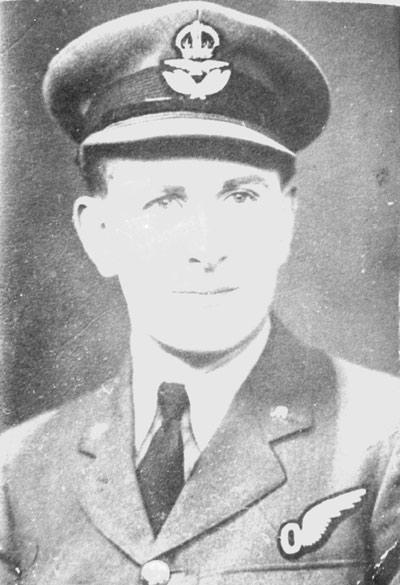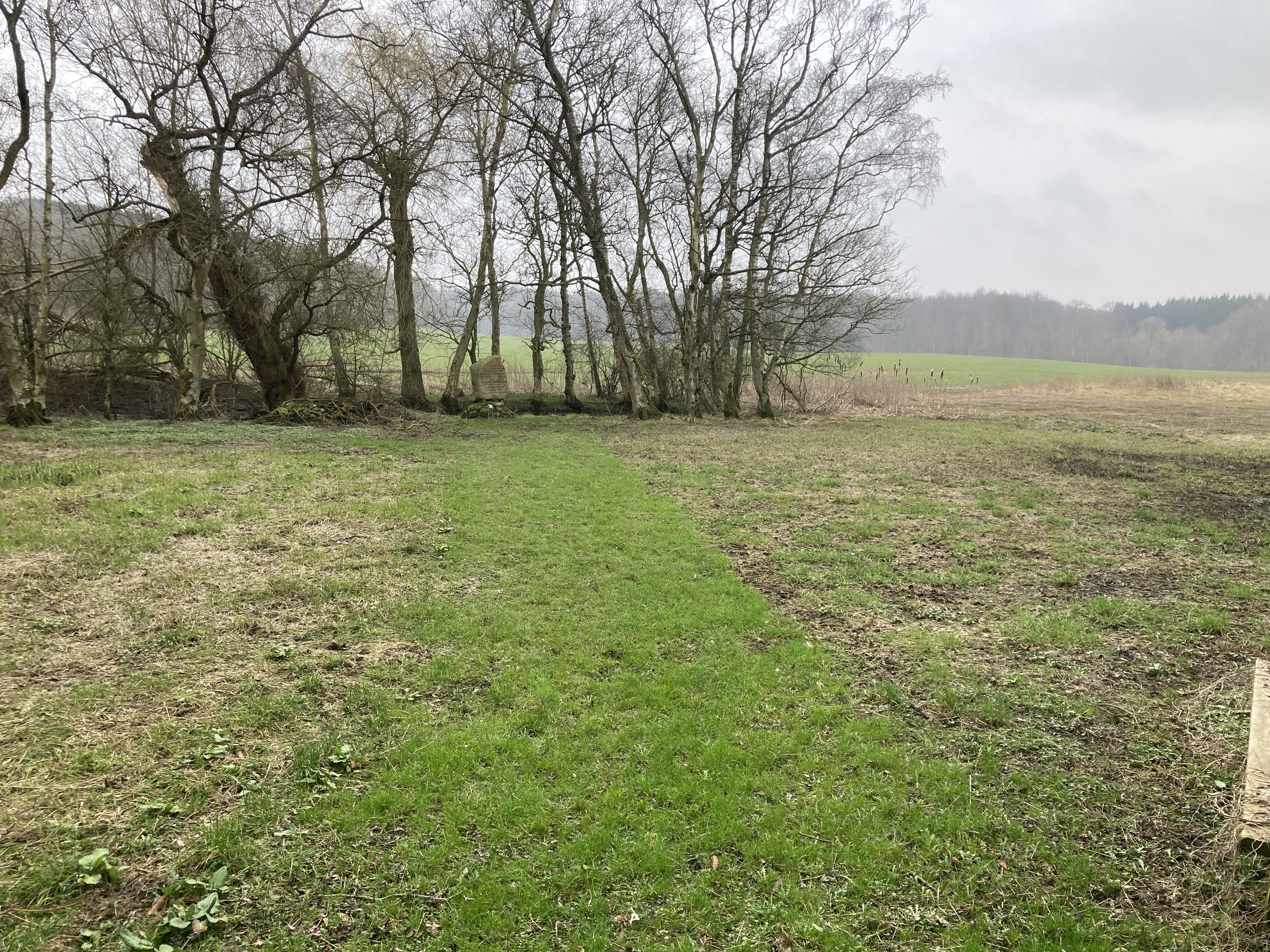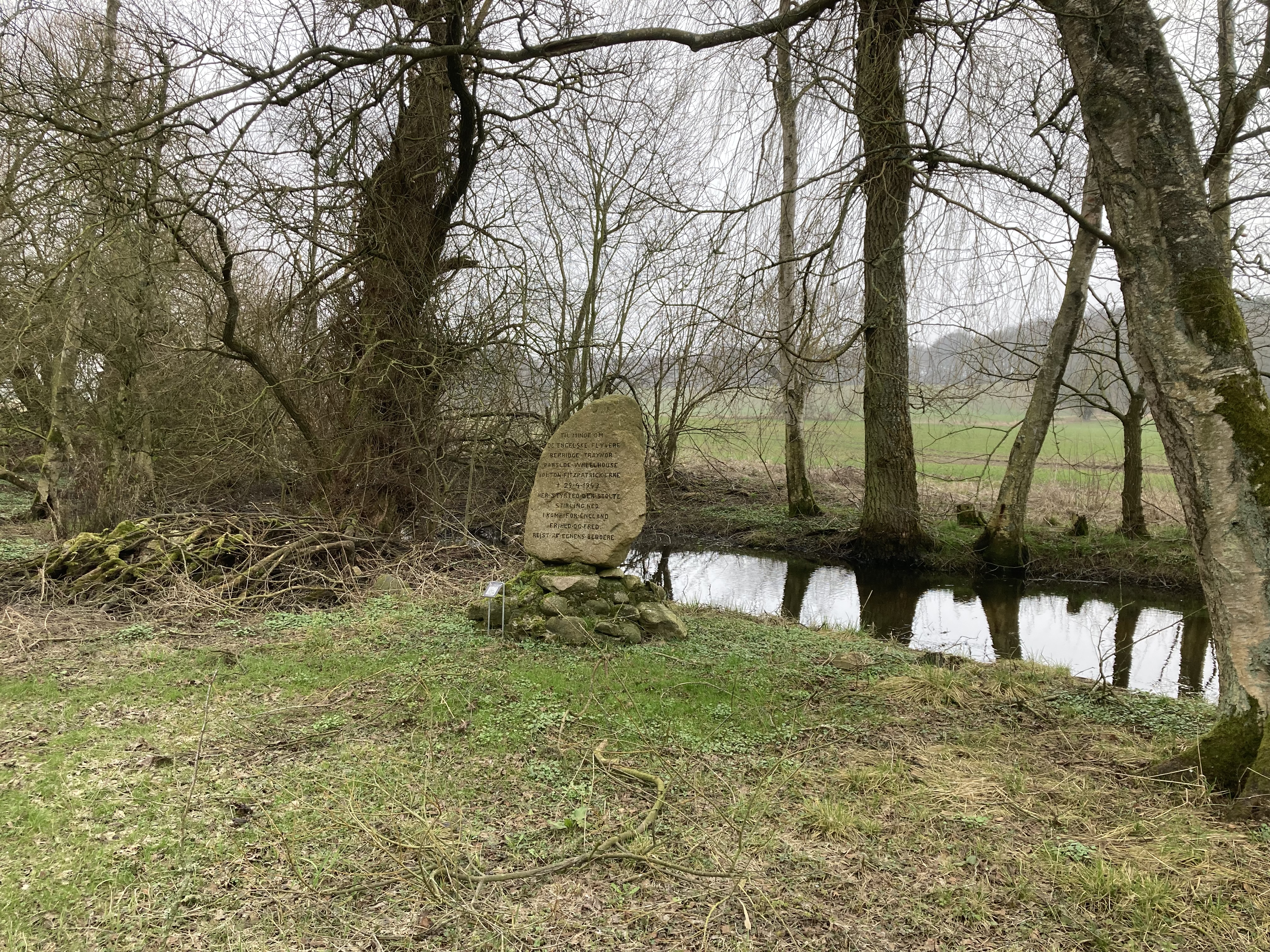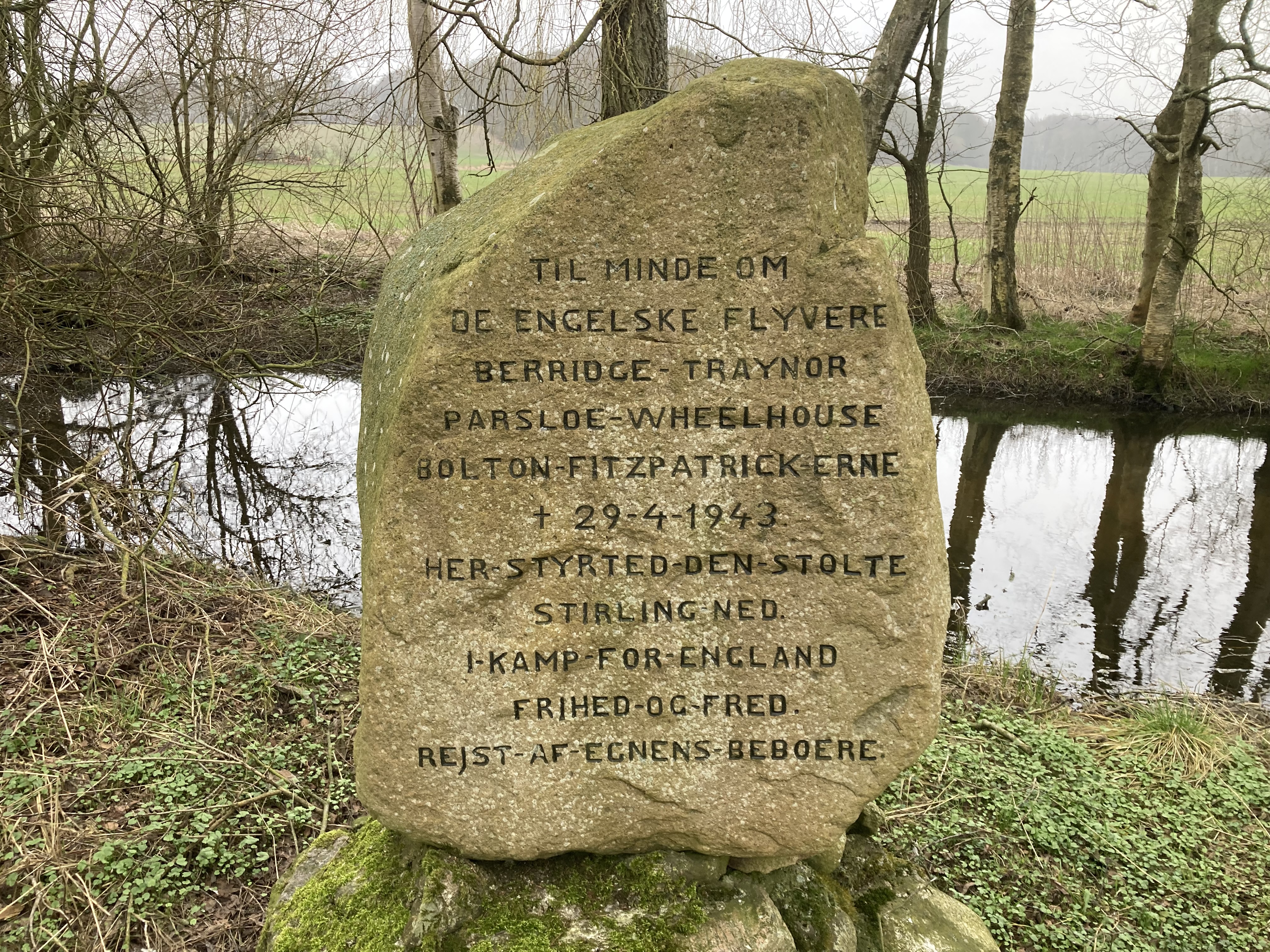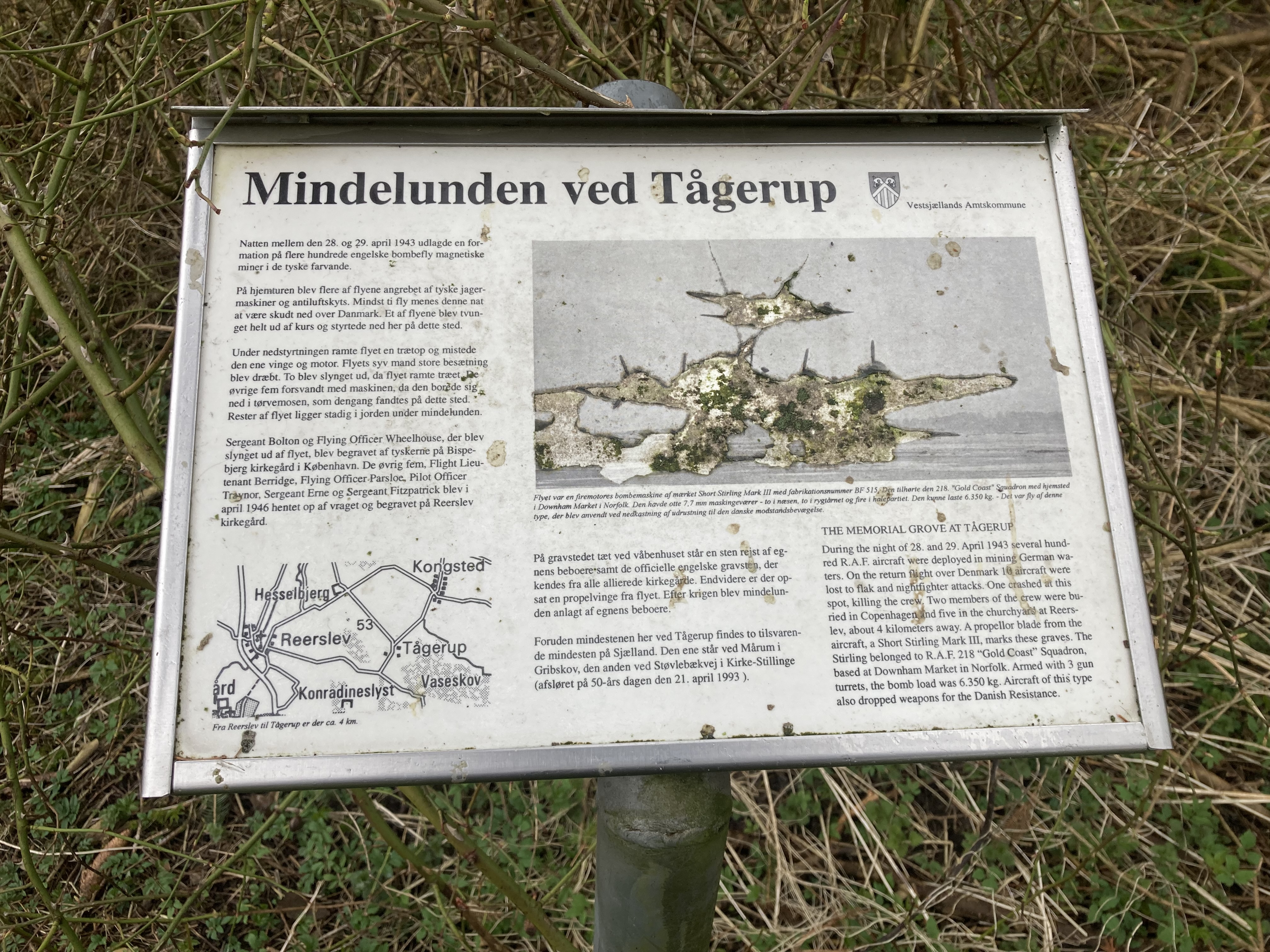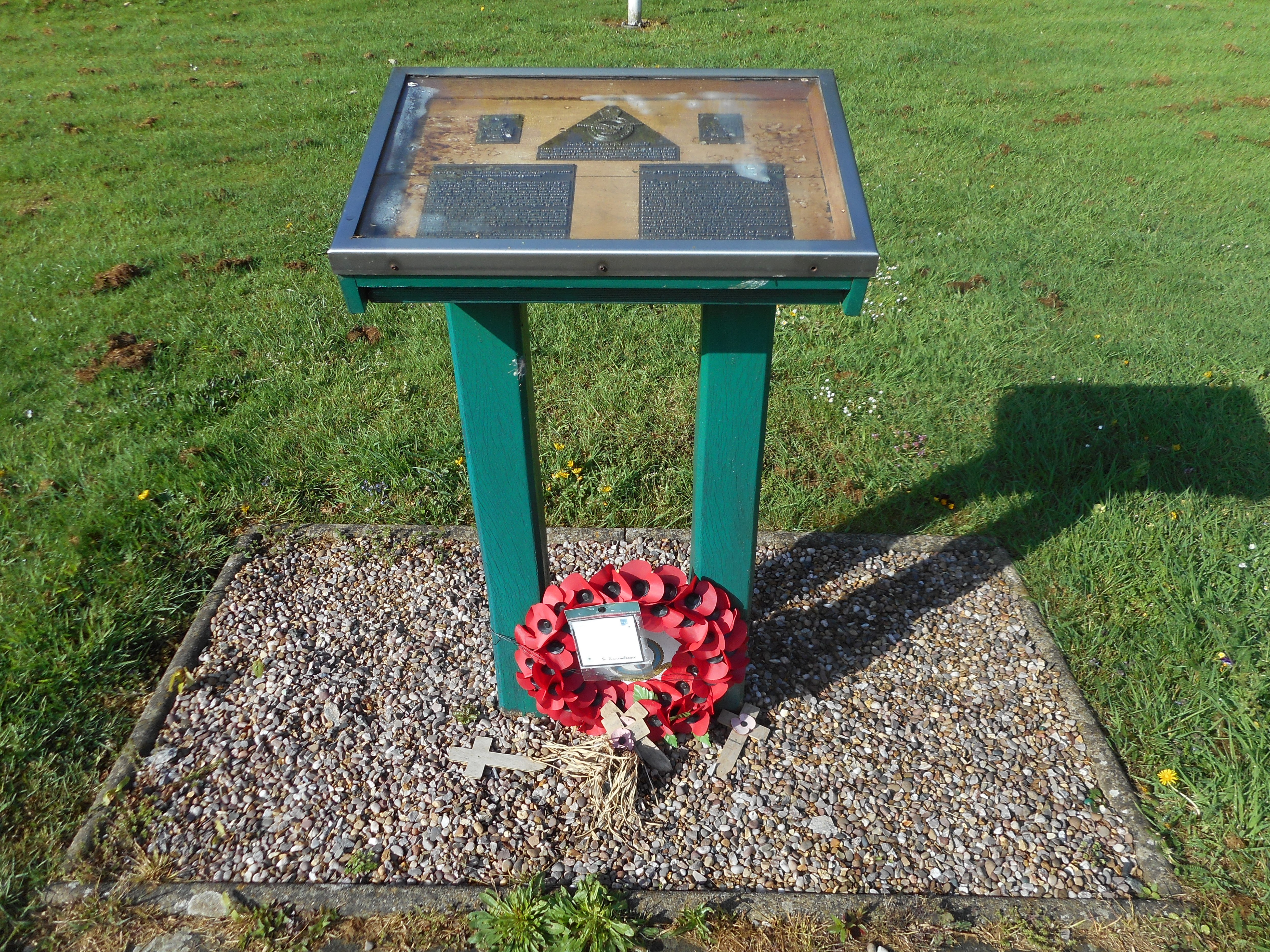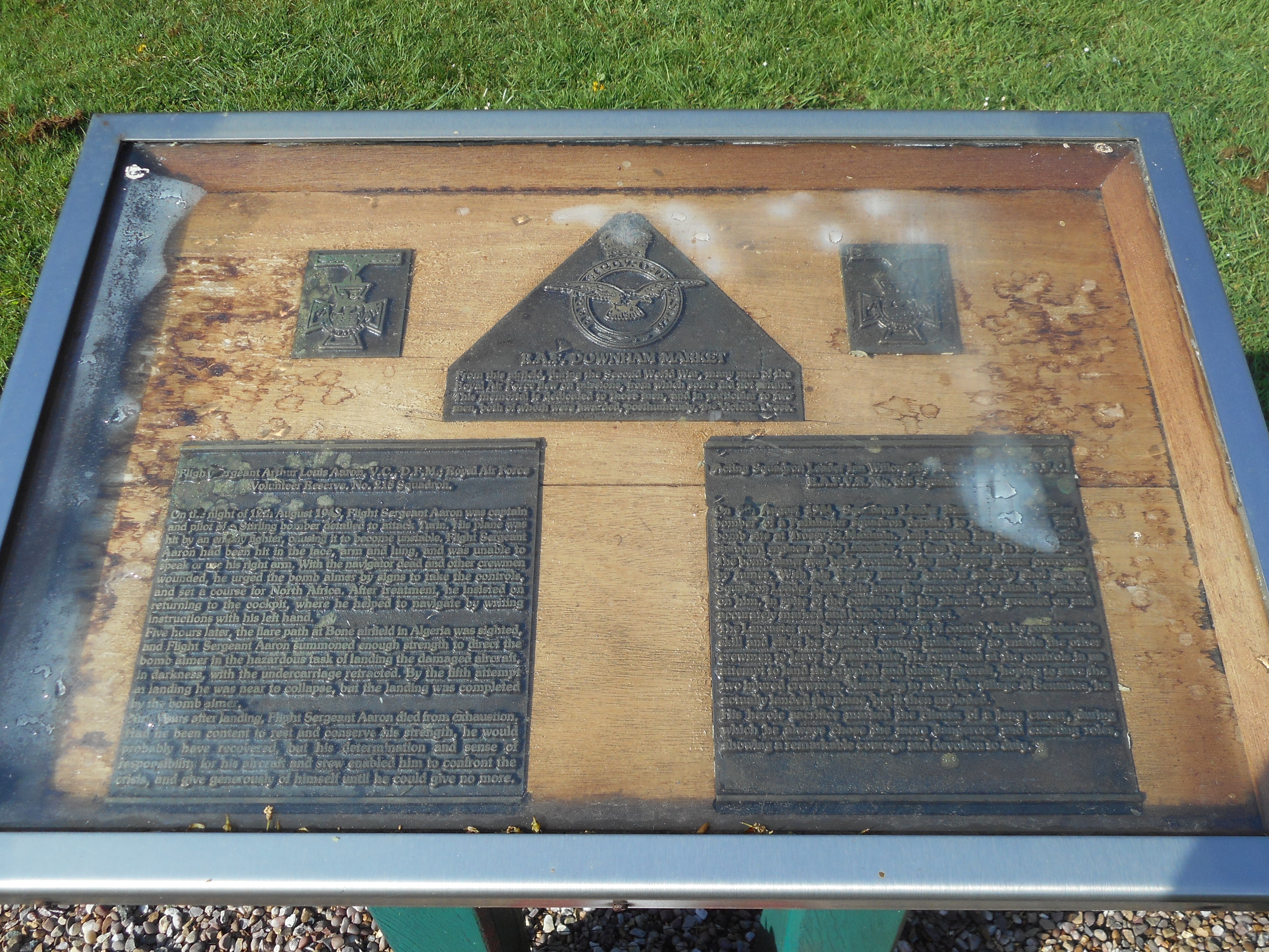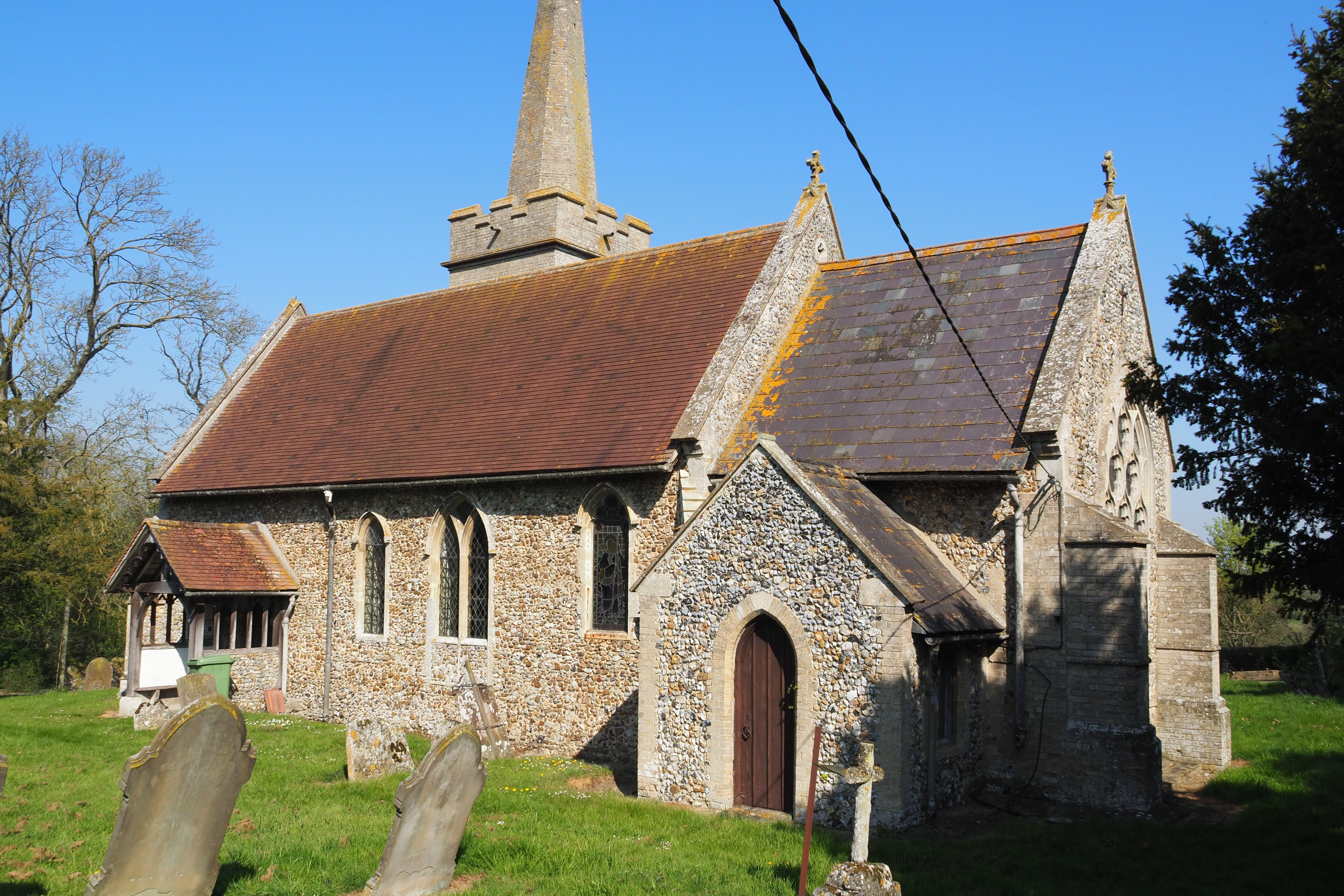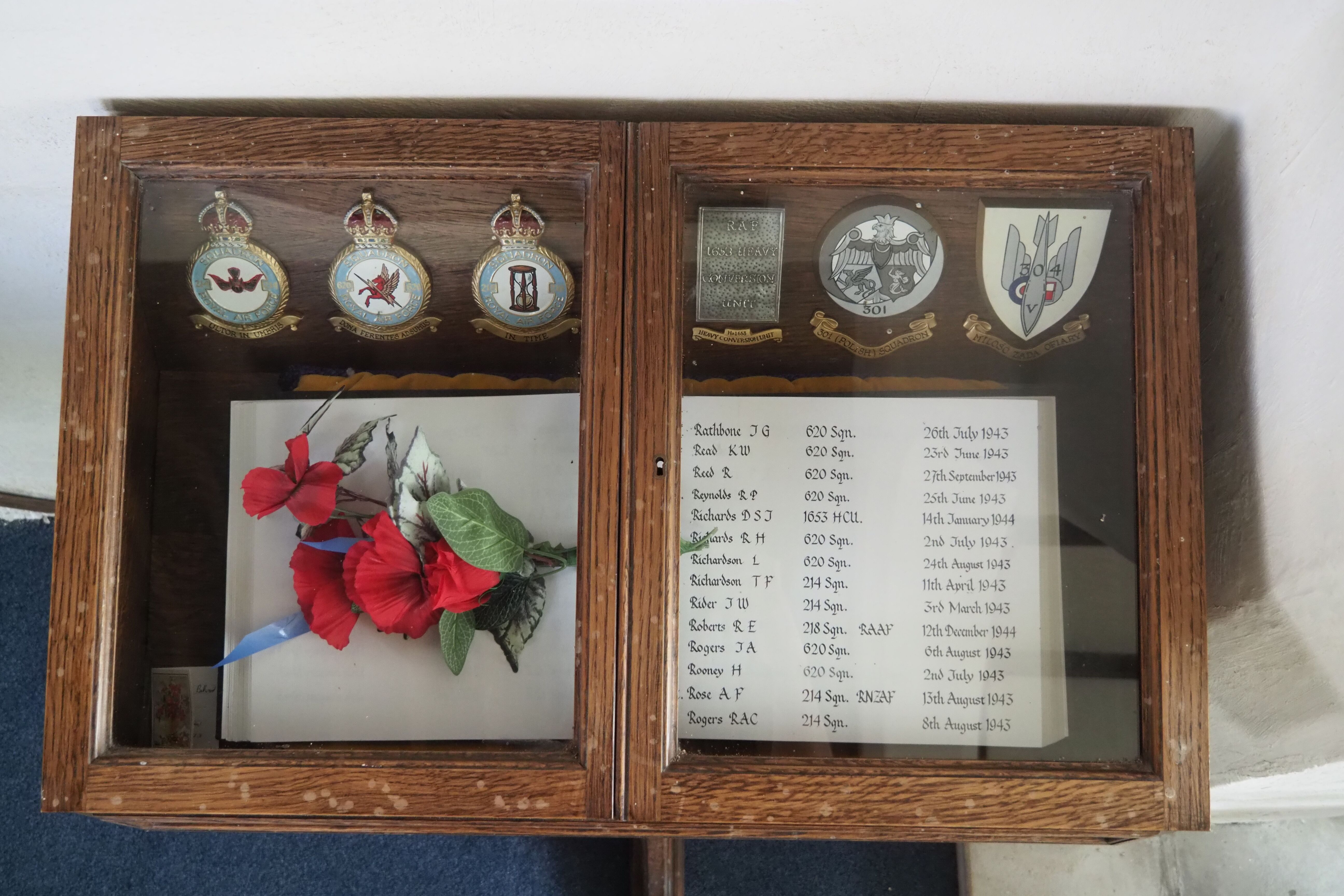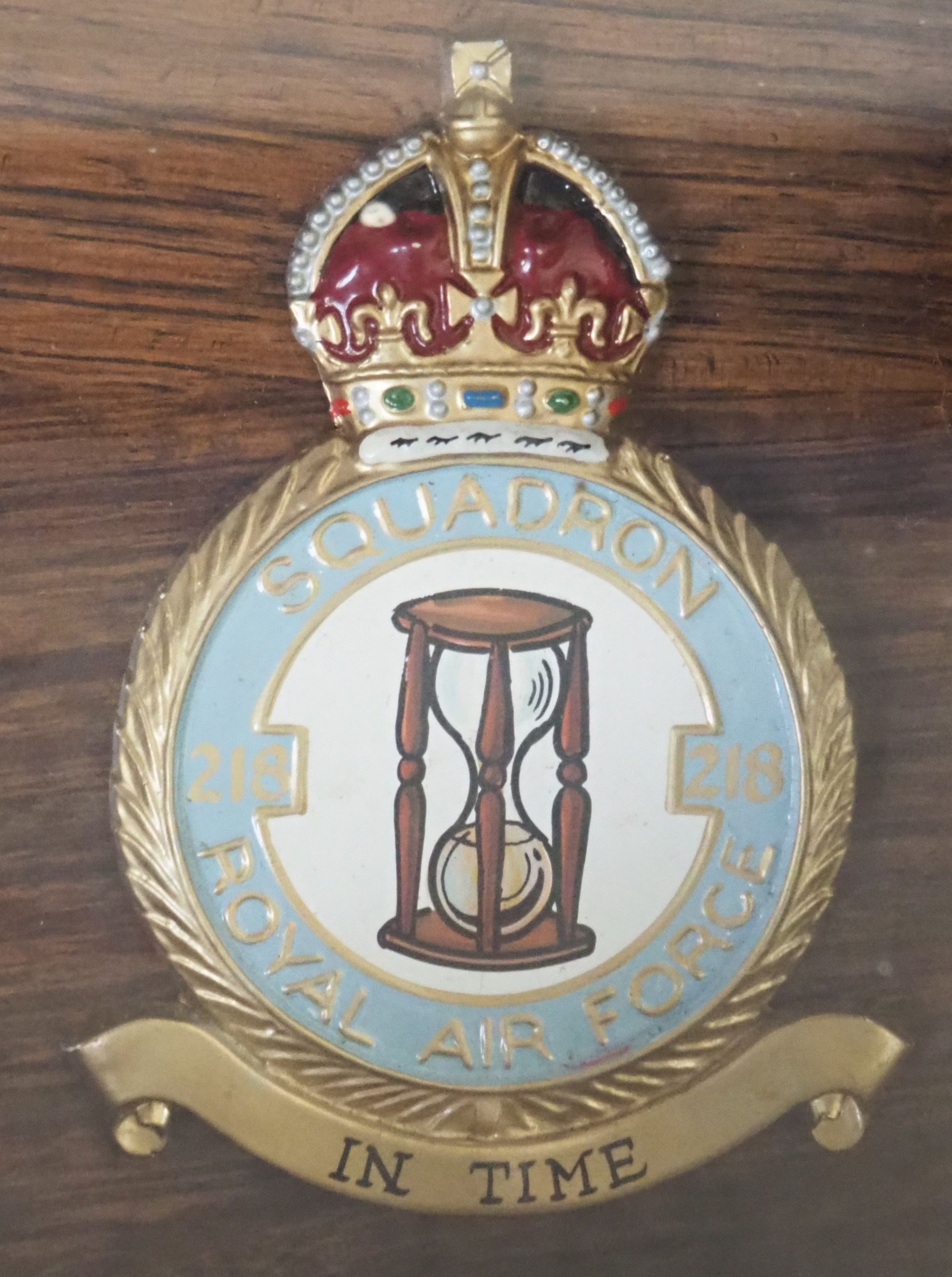| Taken from a Danish Newspaper Report written for the 40th Anniversary and reproduced as part of the BBC WW2 People's War project (an online archive of wartime memories contributed by members of the public and gathered by the BBC. The archive can be found at bbc.co.uk/ww2peopleswar'):
WHEN ENGLISH BOMBER-PLANE WAS SHOT DOWN CLOSE TO TÅGERUP.
The night between Wednesday the 28th and Thursday 29th April, a formation of English Stirling-planes flew over Denmark from a mission covering German sea-territory. That the night activity was of exceptional dimension shows the fact, that the air-raid alarm in the Kalundborg area lasted nearly 5 hours, which was the second longest period at that time. In Korsør the air-raid alarm was on from 23.45 hrs until 0.400 next morning. Contrary to the Kalundborg area, the German anti-aircraft batteries were in heavy action here. Eyewitnesses saw, that at least one plane was shot down approx 4km over the Great Belt. Over Ruds-Vedby there was heavy fighting in the air around 0.30 hours. Many inhabitants were awakened by motor noise and shooting.
EYEWITNESSES REPORT
Previous stationmaster V. Zohnesen can report, that he that particular night noticed, that something serious was about to happen. He could hear heavy shooting at a plane in the air in the immediate vicinity of Ruds-Vedby. V. Zohnesen therefore immediately left for the Falck-station, and whilst he was en route, an alarm was telephoned from Tågerup. He immediately left for Tågerup, together with another Falck-man in a fire engine, which, incidentally had no closed cab. Whilst on the road a German fighter plane flew over in very low altitude, and they feared that they were being attacked. When they came to the place of the crash, they noticed that there was heavy fire in an area of approx. 500 metres in diameter — components of the plane had been spread all over the area when crashing. The body of the plane had gone down in a peat-hole not far from some farms. It seemed strange, that it had nearly disappeared into the earth. It still burned slightly and we began therefore to put out the fire. Zohnesen went around looking for possible survivors, but it became very soon apparent, that this was in vain. Together with the Falck-crew he remained on the site the remainder of the night and some of next morning, and when it became daylight, they found the remains of the plane crew.
NEVER BEFORE SO MANY PEOPLE IN TÅGERUP
In the hours after the crash people streamed to the site to view the incident. From the German camp in Slagelse came soldiers, and also Danish police came to the site to make a report. Especially the next day many people came to the site of the crash and as another eyewitness reports, never before and never since have so many people been in Tågerup. Several eyewitnesses comment on the crash itself, that it seemed as if the engine at an altitude of approx. 2000 Metres was hit by a minor explosion, which caused it to break up in several burning parts. This coincides very well with the fact that the following day the tip of the wing with engine was found several hundred meters from the actual crash hole.
GERMAN SHOT AT BOY
When one of the spectators — a boy of approx. 8 to 10 years old — came too close to this wing, one of the German guards fired a rifle shot in the earth between his legs, thereby giving him the fright of his life. This caused much anger with the spectators against the German and they commented, that he could have shot [at] the boy. To this a pro-German Dane, of which there also were some, replied: ”they don’t shoot that bad either”.
THE PROPELLOR IS REMOVED
But a boy approx. 12 years of age succeeded in removing one of the propellor blades and with this on his bike he left for Kongsted. Unfortunately for him, the local police officer from Ruds-Vedby had observed this and he went after the boy and confiscated the propellor blade, which he kept until after the war.
PEOPLE BECAME RED AROUND THE EARS
People talked a lot about, what kind of an engine it was. Most meant that it was an English plane, but it was difficult to see and the Germans did not say anything. Whilst people walked around and looked not very nice things were as usual said about the Germans. After all they just stood there and looked after the plane, and did not understand a word of what was being said. There was a Dane who commented: It is probably one of their own planes, since they are so afraid that we shall see anything. Then soldiers carrying a rifle came to him and said in perfect Danish: “It is an English plane, but be careful of what you say aloud. I have heard everything you have said, but I won’t tell further”.
We talked with him for a while, says a Reerslev inhabitant, and he told us that was from South Slesvig and had lived for a number of years in Denmark. Unfortunately, he had no Danish citizenship and hence, when the war came, was enlisted as a German soldier.
GERMANS TRY TO GET PLANE UP
During the days after the crash the Germans closed off the area entirely, so that with a crane could lift the body of the plane, perhaps so that they could discover secrets in the plane’s construction. With their violent action they completely disregarded the 5-killed English crew, who were still in the plane. The German action did not succeed, however. It proved impossible to get the plane up and the only thing they got that could be used was the tip of a wing and the engine, which had landed on a field. Perhaps in anger because of the poor result, the Germans filled up the hold with waste and an old car wreck.
As a reaction to this fearsome incident, the inhabitants of Reerslev formed an association, which should assist with fire-combat and first aid in case a similar incident was to occur. Funds were being collected for this purpose, so that the necessary material could be purchased, and a permanent telephone duty watch was established on the number Ruds-Vedby 214.
THE FIVE AIR-CREW WERE LAID TO REST AT THE CHURCH IN REERSLEV
When the war was over, the incident of the crashed plane in Tågerup was taken up again. The allied forces were extremely interested in getting all information possible on the missing plane. Enquiries were being made in Denmark, but it was no easy task. Many planes had disappeared into the sea, and in such cases it was often impossible to locate the wrecks. But also crashes on land could present great difficulties. The engines often exploded when crashing, and it was the Germans who further examined the wrecks. And the Germans, in the final phases of occupation, were not very reverent to killed allied flyers. In April of 1946 investigations were being made on West Sealand. Information was being gathered on a crashed plane near Kjeldstrup and another near Drøsselbjerg Beach. A third plane was supposed to have crashed in the Great Belt outside Korsør on the same night as the Tågerup crash, but this plane was possibly already some time ago lifted by Germans. The Tågerup plane, however, was still in the peat hole. The hole was still visible and [in] early April 1946 24 soldiers from the 14th Battalion, 1st Company commenced to dig out the plane. H Jensen engineer with the Moor Company had already made some drillings and determined the exact location of the wreck. Lieutenant Herboe, who was in charge of the soldiers, knew therefore exactly where to dig, and a couple of meters down they found wreckage parts. Experts were of the opinion that there were no bombs in the wreck. When crashing no explosions took place. It was most probably an empty plane returning home to its base, but of course one could not be entirely certain, so the digging was done very carefully.
STIRLING — NOT STERLING
During the excavation it could very soon be verified, that it was a Stirling bomber, and a cylinder block, carrying the production number, was found and the engine could hence be identified. Stirling, and not Sterling as people generally called it, was a 4-engine bomber. This type of plane had been in use since the early start of war, and was at first the only big and heavy bombing plane England had. The Stirling plane had comparatively short and sharp wings and could not fly at such high altitudes and so fast as other bomber planes, which England built in the course of the war. For safety reasons Stirling planes were during the end of the war used specially for night operations. Stirling planes were for example used to drop down weapons and ammunition to the resistance people. A Stirling plane could however, defend itself. A 7,7mm machine gun was located in the nose of the plane and also in the tower. In the Tail 4 similar machine guns were located. Stirling planes were furthermore well known for being able to tolerate quite heavy damage and still being able to return to base.
EXCAVATION
The plane could carry a bombing load of 6350 kgs, and often it carried mines, which were dropped into the sea to destroy German supply lines. Ship’s traffic was of vital importance for the Germans in the East Sea. There were iron transports from Sweden and traffic to the Baltic countries, and allied planes bombed Northgerman harbours heavily and mined the East Sea and the Danish Belts. The Tågerup plane had dropped magnetic mines in the East Sea and was on its way home, when it was shot down. It had virtually buried itself and the excavation was therefore a difficult task. Inspector Madsen, who belonged to the resistance, and two RAF officers followed the excavation. They asked people to come forward with information on this plane, and others that might have crashed on West Sealand. It was well known that people had removed many parts of the planes, and it was asked that the get permission to examine these parts, stressing that no confiscation would take place. It turned out that the morning after the crash a press photographer had been on the site and had taken some pictures, which could be used to identify the plane. During the excavation personal items turned up. A watch with the owner’s name engraved helped to solve the mystery, and furthermore it was now known that the Germans had found two crew members: John Albert Bolton and Thomas Charles Wheelhouse and buried them on the Bispebjerg graveyard in Copenhagen. It became therefore very soon apparent which plane it was, and one knew that no one have survived the crash. Digging was continued to find the other crewmembers so that they could be properly buried.
MCKEEVER AND HORNUNG
The two RAF officers were McKeever and Hornung. Hornungs family came from Slagelse, where his grandfather had had a merchant house on the Schweizer hall. Perhaps his connection with the Slagelse area played a part, when he was assigned to this task. As far as McKeever is concerned there is no doubt that he was chosen because he poke fluent Danish. He was furthermore a code expert. Whilst the work in Tågerup was going on, the two RAF people had negotiations with the priest in Reerslev. A burial site was placed at disposal and the inhabitants of the parish decided that a stone should be erected on the grave.
THE BURIAL
The burial took place on the 15th April 1946. A spring day, warm with sun. The coffin carrying the remains of the dead aircraft crew was carried from the chapel by six members of the resistance. The coffin was followed by Captain Hornung, Captain McKeever and Squadron leader Philhin. Soldiers from the 1st Company marched before the coffin and on the porch of the church 12 policemen formed an espalier. The little country church was filled to standing. Three hundred people attended the ceremony in the church and in the graveyard another hundred followed the ceremony through loudspeakers, which had been rigged up. Priest Løgstrup remembered his speech for the dead, how many flying missions had helped to keep the spirit up in the population. England could not have been beaten if night after night they sent planes against Germany. “Uncertainty is always appalling, and in five homes over there they do not know yet, that we are gathered here today in Reerslev in a memorial ceremony. In our little parish we do not know these flyers but we have opened our hearts and considered them as our sons. The grave, where they are now being put to rest, we shall consider as a parish grave and we will ornament and protect it.” McKeever spoke also and thanked the people for the help they had offered. “It is a great comfort for those left behind to know that their sons do not rest in the jungle of the East or on the bottom of the sea, but in kind earth in a country, which has shown great respect for our fallen soldiers.” The coffin was then carried to the grave, just outside the porch. The Priest then officiated at the graveside ceremony and concluded with the words “God’s peace with the English dead in Denmark’s roseyard”, the same words which later were engraved on the Danish stone. The ceremony ended with the firing of a salute. McKeever thanked the participants and gave special thanks to Inspector Madsen, Engineer Jensen, stationmaster Zohnesen and the Danish Soldiers. “It is a special pleasure for us to be able to say to the bereaved, that what could be done has been done”.
DISTINCTIVE GRAVESTONE
Later a stone was erected on the grave with the names of the five airmen: Gordon Frederick Berridge, Cyril Vicent Parsloe, James Mellon Traynor, Kenneth Frank Erné and Arthur Allan Fitzpatrick. Parsloe’s age is not known; the others were 21, 23, 20 and 21 years old. The propellor blade, which the police officer had kept, was placed before the stone and later there arrived from England 3 gravestones. In the church porch pictures of all 7 crewmembers were hung. On the site of the crash in Tågerup a memorial stone was erected. The veterinary in Ruds-Vedby, Mr Much-Petersen, stood for the collection and paid a great part of the expenses himself. He saw to it that the actual site of the crash got status as a memorial place. Today, 40 years later, the site has a little pond with old birch tree around it. The place is situated at the end of a peat-hole at the Skovvang road in Tågerup. On the graveyard the propellor blade can still be seen, although it is somewhat corroded now. It would be a shame if it was destroyed completely, and it should be removed indoors. As far as the gravestones are concerned, there is a peculiarity in that the Danish stone and the three English stones do not have the same date. This is due to the fact that the plane crashed ten minutes to one Danish time, but ten minutes before 24 hrs English time. English time. All this is the Danish conclusion of a story, which is English. We do not know much of the English story, but it has been told that many years later a young girl came to Reerslev to visit her father’s grave. A father, which she had never seen or known.
(NB. the two Airmen buried at Copenhagen immediately after the crash were: J A Bolton, and T C Wheelhouse). |
